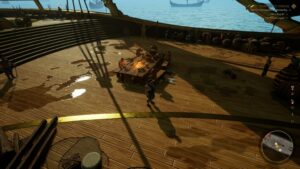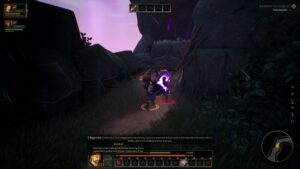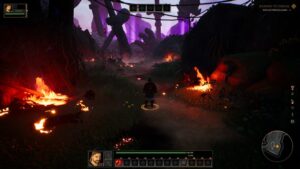There are reasons that video games move on from certain tried and true methods. Whether it’s better attempts at immersion, streamlining, or just the intention of bringing in more money, sometimes games change for a reason. Gato Studio’s “The Waylanders”, which came out on February 2, shows just why some of these methods are left in the background, among many other problems.

The Waylanders is an RPG developed by Gato Studio. Taking place in a world of historical fantasy where the Celtic gods are real and various races from Celtic myth also walk the earth alongside humans, it starts off promising. The King of the Celts travels to the island of Inisfair in order to meet with the Tuatha de Danaan, their gods, negotiations go catastrophically wrong and leave the player character and their party thrown out of time, leaving the player character forced to explore this new era to find out what happened.

While the setting is ambitious and grandiose, unfortunately the actual game doesn’t really live up to it. The Waylanders at least looks visually appealing. The world is bright and colorful and beautiful, really giving you a good sense of scale for the sort of adventure that you’re going on. Water looks beautiful and the soft colors of magic that is flung about during fights is also interesting, but the art style doesn’t lend the epic setting much help. Character models are very cookie-cutter and very rarely differ from one another, and the facial animations also leave much to be desired.

The facial animations and character models are only one part of lacking presentation, as well. For an epic setting, the dialogue is brutally inconsistent in tone and is often lacking in much quality, or even in many cases satisfactory tone. Curse words and lewd remarks are thrown about with abandon, and even work to ruin what should be dramatic, shocking moments. One party member reacts to the arrival of a wolf god declaring his intention to devour the mortal world by remarking on how he’s kind of hot, for instance, which immediately took me out of the gravity of the scene. And that’s not even getting into the vocal direction.

The vocal direction in The Waylanders sounds like the first reading of an amateur screenplay. Alongside the banal dialogue, line delivery is often flat and monotonous with very little emotion behind it except in a few rare cases. The audio balancing is also awful; many characters are almost inaudible, even in peaceful instances where there isn’t anything dramatic happening. Considering this is a game that’s advertised to be inspired by Baldur’s Gate and Dragon Age: Origins, two different games where dialogue was a great part of character appeal, this doesn’t really help the case, to say nothing of how the characters’ personalities are fairly one-note, from what I played. In the prologue and tutorial area you have the arrogant mage, the dumb brute, the sultry and almost constantly-horny woman, the spoiled prince, and the old veteran, with very little depth shown among any of them, though there are others that appear later in the story.

Another way that The Waylanders attempts to take inspiration from games like Dragon Age: Origins and Baldur’s Gate is the combat system, a sort of real-time-with-pause system that allows you to pause the game to make tactical decisions in the middle of combat. However, much like many of the other things that the game attempts to imitate, the combat falls very short. While it does attempt to do its own thing with certain creative mechanics, these did little to alleviate my feelings of boredom during the combat.
The Waylanders, alongside the usual special moves and abilities you can use during combat, also includes a mechanic called Formations, where certain party members can join up into fighting formations with other party members to help increase your combat power through a variety of abilities, such as charging forward to knock down all enemies in your path to a certain point, concentrating a party’s worth of attacks on a single enemy, and more. It’s possible that the Formations were intended to alleviate how every enemy seems to be a damage sponge. Combat, therefore, is mainly relegated to watching your characters endlessly hit enemies and do small amounts of damage at a time, though this can also be alleviated with teamwork as all RPGs can be.
All the same, the lack of panache or flair to combat in The Waylanders doesn’t help matters with the game, as it just devolves into an avalanche of mindless clicking. Combat encounters are also less of an RPG-style and more like an action game, as during battle more enemies will often pop into existence to lend even more clicking into the mix.

One of the game’s few saving graces was, thankfully, that it was fairly stable. I didn’t really encounter any bugs or issues other than a large amount of texture pop-in when cutscenes began, and even if the character models didn’t really have all that much detail on them, clothing at least looked nice and detailed even with the art style.
While the game might hold an interesting story if you’re able to stomach it for longer than I did, The Waylanders’ multitude of issues don’t really hold up to its grand ambitions when it all comes down to it. If you can move past these issues, however, The Waylanders does seem to have an interesting enough story to hopefully keep people invested. While the game does have a great deal of promise, it’s going to need a lot of work before it’s anywhere near a state I can find investing. Overall, at least it tries, and so is worth a 5 out of 10.

